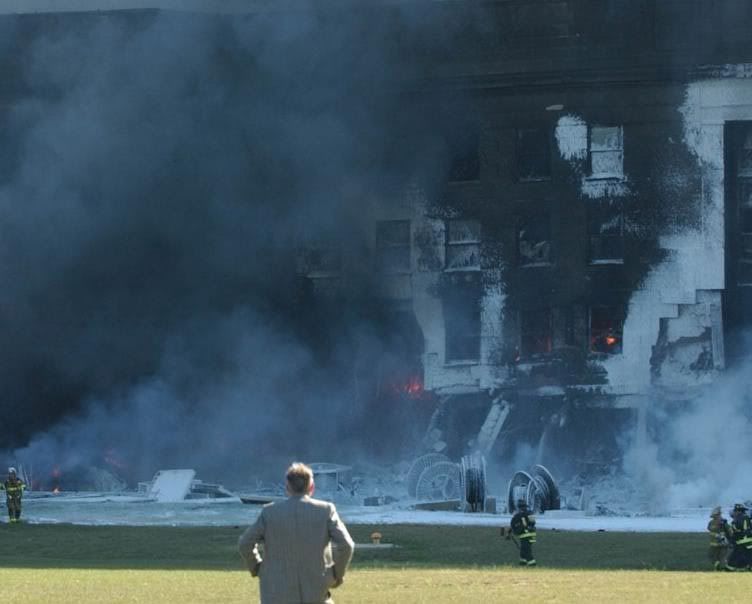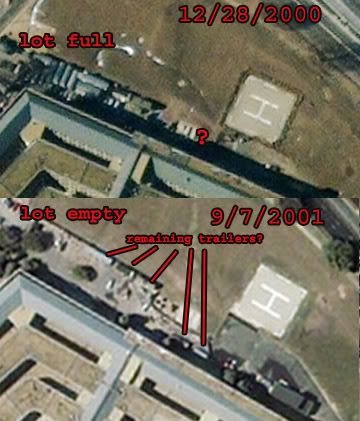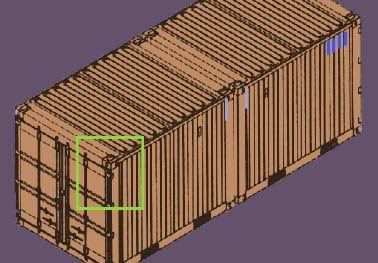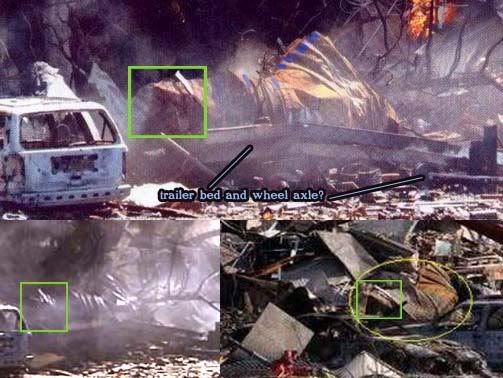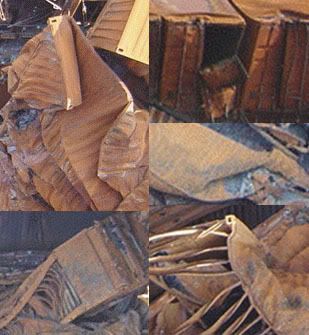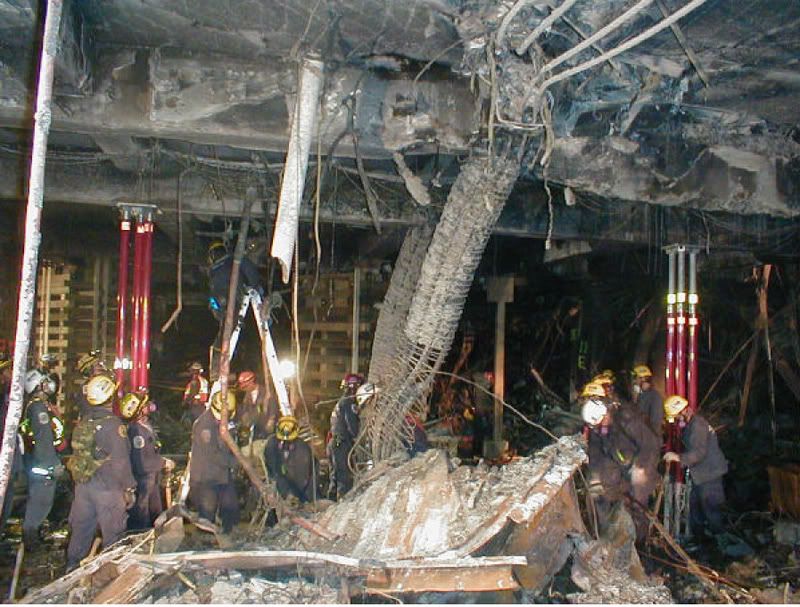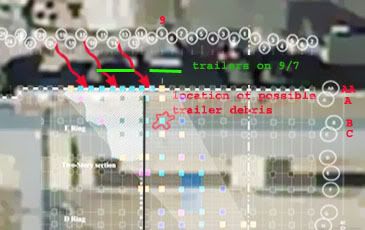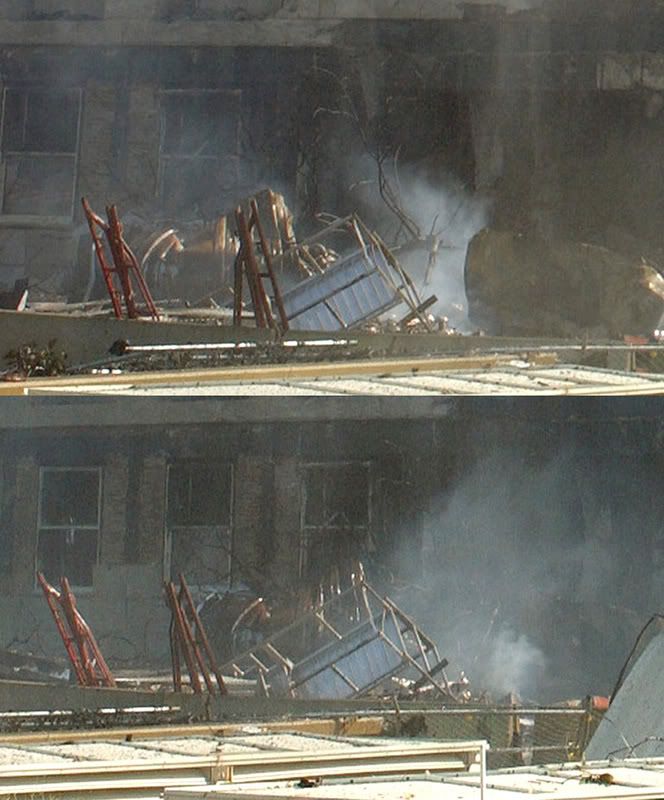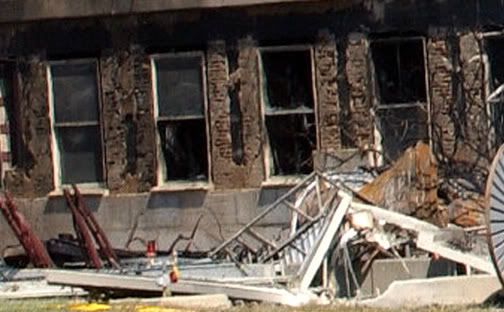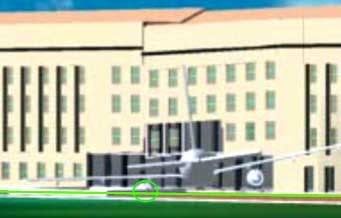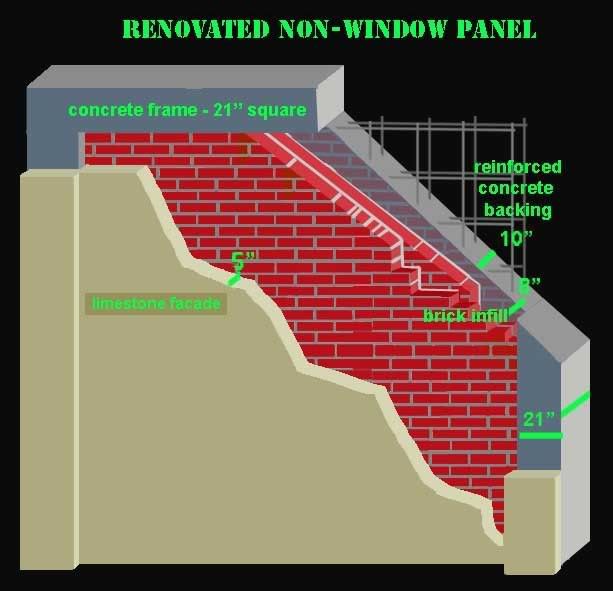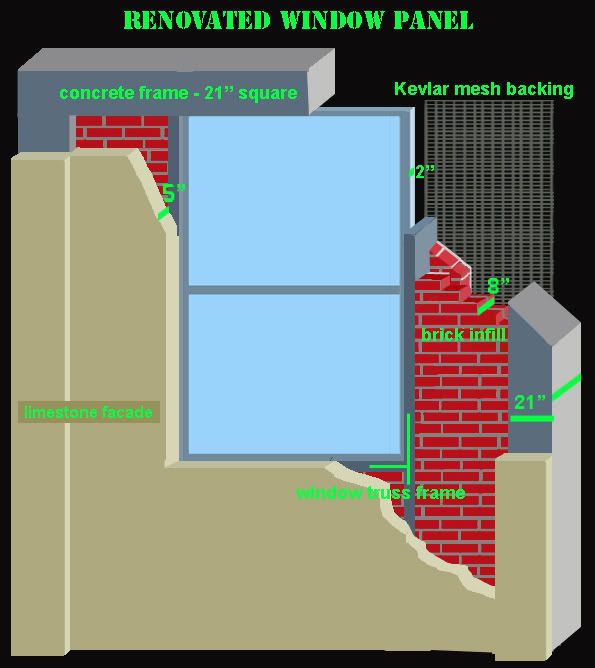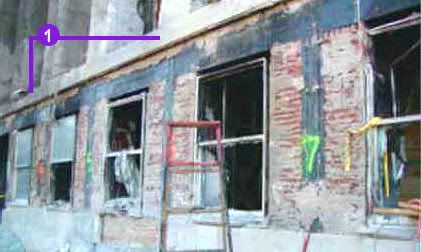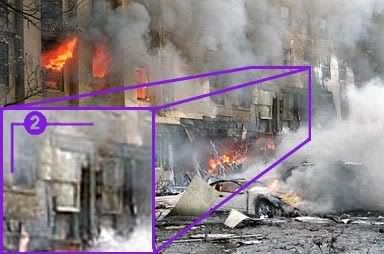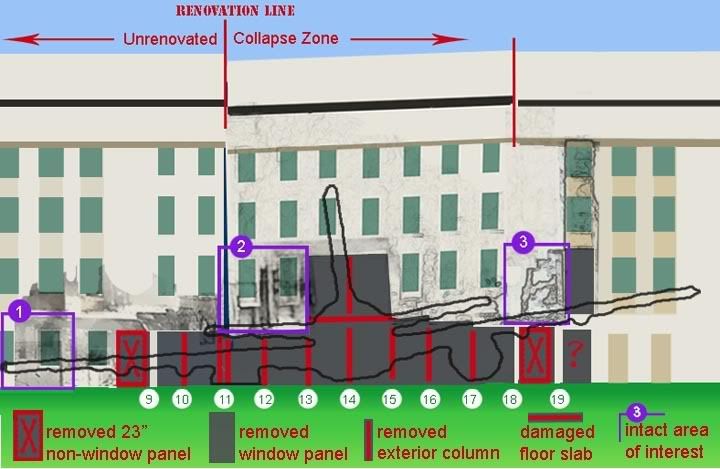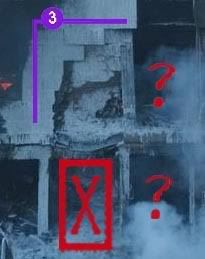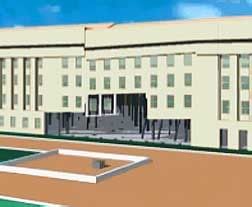Adam Larson / Caustic Logic
The Frustrating Fraud
May 13 2008
updates/edits 5/14 1am
Semantical note: To avoid any misunderstanding as has happened in the past, over interpretations of the ‘normal’ meaning of various key terms, I am taking ‘cookie-cutter’ as meaning an unnaturally similar shape between the damage and the damager and ‘cartoonish’ as similarly meaning unrealistic, in defiance of normal principles and dynamics of the alleged event. Examples: Ranke dismissing my “sarcastic little list of cookie cutter yet anomalous damage” that “means nothing” in the face of their growing list of “evidence” against the impact. Ranke again: “Now we know why the physical damage is so anomalous and questionable yet cookie cutter in many ways.” [source] Proceed.
---
The image below has been offered about lately by Citizen Investigation Team (CIT) for the ‘anomalous’ impact damage at the Pentagon’s façade. This useful and pretty accurate resource, based on a montage by Pier Paulo Murru (who also did their famous flyover animation), clears the smoke and debris to let us see the structural situation. CIT has improved on it with their red outline that seems to denote the intact structure, but ignoring the first floor columns and non-columns entirely.

CIT’s Craig Ranke noted beneath it at one post ”Just looking at the initial anomalous and admittedly "counter-intuitive" damage to the building (and lack there of) and it becomes clear that it was not caused by a missile or a plane.” CIT, at least, feel the evidence is counter-intuitive because it’s absolutely wrong for a 757 impact and a better fit for on-site (or in-site) explosives. In the past they’ve argued it doesn’t match a plane impact at all in key ways, like with the lack of tailfin damage, or foundation damage, which they assert. When others point out how the traces of what happened in fact line up quite well with such an impact, CIT do admit that was the intent of the operation and that it was somewhat successful. Aldo and Craig will not tell you about the 16-foot hole, and they do admit to some plane parts inside (pre-planted). In fact in some cases, which we’ll look at here briefly, the problem with the evidence seems to be that it matches the impact story too well. There’s always something wrong.
The damage shown above is what CIT ally Avenger meant when he said “the plane supposedly flew into the Pentagon wall diagonally, but that cleanly cut impact hole is NOT diagonal.” [emph. mine] I’m guessing by ‘diagonal’ he meant with a wing bank, but indeed, the damage seems all horizontal – almost like weak panels removed from a building with a strong horizontal frame. Craig praised him anyway: “Leave it to Avenger to cut to the chase with pure, basic, factual knowledge! This is the most simple and brilliant point that virtually everyone ignores. Particularly the 757 impact "scientists" who say that all the physical damage "lines up perfectly". It does NOT. Sure it's in a straight line but it is ridiculously cookie cutter and anomalous.” [emph. mine - source] I still can't fully understand what this statement means, but it does appear surreal, or rather fragmented and cubist, almost like something was breaking the realistic damage up into rectangular areas of varying destruction – extremely low Atari bit-rate in the op planning blueprints? Or steel-reinforced columns and beams?
 The best part is when we get to talking about the faked or so-called engine damage, thee manifestations of which were compiled by Ranke as seen at left (with engine face and words added by me). He has focused most intently on the famous spot where the left engine chipped the retaining wall of the ground-level vent structure just before impact (top photo). “If you accept the notion that this damage was caused by an RB-211 you open up a whole host of other problems with the physical evidence. First consider the cartoon like curvature of the damage as if it was perfectly punched out by the bottom of the engine” [emph. mine] I’m not exactly sure what sort of realistic shape he’d expect here where a heavy, fast-moving, round object is said to have impacted a weak concrete wall. A jagged triangle with spirals of rebar? Are we sure it wasn't just the very edge of the engine, and the shape of the damage was even larger, determined by the concrete itself? What more does Ranke know about this than I? It seems to me of all things hit, this is the most likely to behave like a cookie, considering the conceptual similarity of dough and concrete.
The best part is when we get to talking about the faked or so-called engine damage, thee manifestations of which were compiled by Ranke as seen at left (with engine face and words added by me). He has focused most intently on the famous spot where the left engine chipped the retaining wall of the ground-level vent structure just before impact (top photo). “If you accept the notion that this damage was caused by an RB-211 you open up a whole host of other problems with the physical evidence. First consider the cartoon like curvature of the damage as if it was perfectly punched out by the bottom of the engine” [emph. mine] I’m not exactly sure what sort of realistic shape he’d expect here where a heavy, fast-moving, round object is said to have impacted a weak concrete wall. A jagged triangle with spirals of rebar? Are we sure it wasn't just the very edge of the engine, and the shape of the damage was even larger, determined by the concrete itself? What more does Ranke know about this than I? It seems to me of all things hit, this is the most likely to behave like a cookie, considering the conceptual similarity of dough and concrete. A while back he expanded the theme to include the bottom photos; “It seems the perpetrators (and some 757 impact conspiracy theorists) expected us believe that similar cartoon like curves were created by the engines on the fence to the generator trailer AND the tree up by the light poles: Unfortunately for the official story this cookie cutter anomalous damage raises more questions than it answers.” It does raise questions like was the tree (middle) chopped by the right engine’s turbofan blades, or burned by its heat or both? Or why would the fakers do it too cartoonish like that? The tree damage is a supiciously perfect fit; relative to the probably irrelevant/easily-faked VDOT camera pole damage and approximate height and nature of damage to light pole 1, a wingtip and engine placement like this is illustrated, matching the official story with cartoonish precision you might say. Another good question raised by this alleged damage is why did they tear the fence in such a perfect curve (bottom)? Everyone knows that actual chain-link fence damage is jagged and angular,like this, causing the fence to lose tensile strength and slump into nice smooth curving shapes like this. Oh, wait… now who exactly has ever said that curve was caused directly by the engine?
 The diesel generator trailer said to be impacted by the high-banking right engine just before impact also bears the stamp of Disney. It was featured prominently in Integrated Consultants’ animation of the official scenario, as seen above, with the engine just punching a nice curved hole in it like it was a block of tofu. I doubt that many really believe this is what happened - it's a cartoon. But the photos of the generator (below, bottom photo) do look a bit like this, with a very large deformation on a scale of an airliner engine and with a curve reminiscent of one. CIT co-conspirator Aldo Marquis explained why this was not evidence for an airliner engine: “Did you ever watch the video of the trailer on fire before it was put out and left the damage you see? If not you should. Look at the damage, it reflects the thin metal sheet of the trailer MELTING into [an] even bend. So the plane did not cause that, the resulting FIRE DID.”[source]
The diesel generator trailer said to be impacted by the high-banking right engine just before impact also bears the stamp of Disney. It was featured prominently in Integrated Consultants’ animation of the official scenario, as seen above, with the engine just punching a nice curved hole in it like it was a block of tofu. I doubt that many really believe this is what happened - it's a cartoon. But the photos of the generator (below, bottom photo) do look a bit like this, with a very large deformation on a scale of an airliner engine and with a curve reminiscent of one. CIT co-conspirator Aldo Marquis explained why this was not evidence for an airliner engine: “Did you ever watch the video of the trailer on fire before it was put out and left the damage you see? If not you should. Look at the damage, it reflects the thin metal sheet of the trailer MELTING into [an] even bend. So the plane did not cause that, the resulting FIRE DID.”[source]  At the time I conceded that the actual curve seen in this metal could not be caused directly by an RB-211 engine unless it was dropped from above, but maintained it was apparently centered around some extensive pre-fire damage that might be compatible with an engine impact. I saw the Pugh video of the raging fire, and even one better – a photo from even before the blaze got bad, taken by Steve Riskus within five minutes tops of the event (middle). It shows a missing area and a damage profile that’s actually quite similar to the post-melting photos, if rougher and shinier, like fresh torn metal. (Note also the large piece of debris off to the left - is this part of what was removed in the collision?) It started out rectangular (top) and even before the fire took hold was knocked out or pre-fabbed almost the same as it looked later when it appeared to many that an engine passed through it like butter. In short: the fire did nothing to this damage but soften it. But as Craig once simmered it down, "the bend in the top corner to the trailer was likely simply caused by the raging fire melting it. […] the damage to the generator trailer and the cookie cutter curved damage to the fence going all the ground makes even less sense."[source]
At the time I conceded that the actual curve seen in this metal could not be caused directly by an RB-211 engine unless it was dropped from above, but maintained it was apparently centered around some extensive pre-fire damage that might be compatible with an engine impact. I saw the Pugh video of the raging fire, and even one better – a photo from even before the blaze got bad, taken by Steve Riskus within five minutes tops of the event (middle). It shows a missing area and a damage profile that’s actually quite similar to the post-melting photos, if rougher and shinier, like fresh torn metal. (Note also the large piece of debris off to the left - is this part of what was removed in the collision?) It started out rectangular (top) and even before the fire took hold was knocked out or pre-fabbed almost the same as it looked later when it appeared to many that an engine passed through it like butter. In short: the fire did nothing to this damage but soften it. But as Craig once simmered it down, "the bend in the top corner to the trailer was likely simply caused by the raging fire melting it. […] the damage to the generator trailer and the cookie cutter curved damage to the fence going all the ground makes even less sense."[source] And finally, another cookie-cutter anomaly that I discovered and that Craig and Aldo have glossed over: the vent door panel beyond the chipped wall, bearing another improbable cartoonish curve. It would seem these doors were propped and locked open at impact and remained so afterwards, but in a different position and with one side swept down severely at the corner, roughly on the scale of a RB211 engine. How convenient! In fact it looks almost melted, like a lot of energy was transferred into it suddenly by some massive physical force. Pure Hanna Barberra.
And finally, another cookie-cutter anomaly that I discovered and that Craig and Aldo have glossed over: the vent door panel beyond the chipped wall, bearing another improbable cartoonish curve. It would seem these doors were propped and locked open at impact and remained so afterwards, but in a different position and with one side swept down severely at the corner, roughly on the scale of a RB211 engine. How convenient! In fact it looks almost melted, like a lot of energy was transferred into it suddenly by some massive physical force. Pure Hanna Barberra. So among the reasons to dismiss evidence of a 757 impact we find “the fact that the curvature in the fence, retaining wall, and tree is clearly cookie cutter and anomalous showing blatant signs of pre-fabrication.” [source] And of course there are the other problems that don’t match, the wrong data that rules out something, and the fact that the plane flew north of the Citgo and wherever else radar didn't show it, and flew over instead of impacting, and the choice is clear. If the cutter fits, you must acquit.
So among the reasons to dismiss evidence of a 757 impact we find “the fact that the curvature in the fence, retaining wall, and tree is clearly cookie cutter and anomalous showing blatant signs of pre-fabrication.” [source] And of course there are the other problems that don’t match, the wrong data that rules out something, and the fact that the plane flew north of the Citgo and wherever else radar didn't show it, and flew over instead of impacting, and the choice is clear. If the cutter fits, you must acquit.---
Cookie Identification Team: "Yes we had a cookie cutter seen in the vicinity, at least five cookies of the right shape, and many witnesses who saw the cutter press into the gingerbread, at least for the final cookie, before their very eyes. But these gingerbread men are too perfect and cartoonish, which indicates they were prefabricated, and a few witnesses saw that cutter over by the sink as the dough was imprinted. Therefore it’s been proven the cuts were done some other way with advance means that can’t be proven or even narrowed-down. Culinary deception is proven!"

